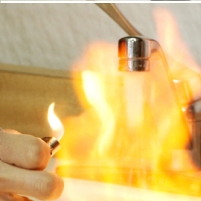Fracking Linked to Flammable Drinking Water
Wednesday, May 11, 2011
 (photo: GasLand)
(photo: GasLand)
The controversial use of hydraulic fracturing (a.k.a. fracking) to bolster natural gas drilling has been linked scientifically for the first time to flammable drinking water.
Four scientists at Duke University found higher levels of flammable methane gas in drinking water wells located within close proximity to natural gas wells. The researchers also found that the type of gas detected at high levels in the water was the same type energy companies were extracting from thousands of feet underground, which could mean the gas had been seeping through natural or manmade faults and fractures, or coming from cracks in wells.
The Duke research involved 68 drinking water wells in the Marcellus and Utica shale drilling areas in northeastern Pennsylvania and southern New York State. Most of the wells had some methane, but the water samples taken closest to the gas wells had on average 17 times the levels detected in wells further from the drilling.
The researchers did not find that any of the chemicals used in fracking had contaminated the wells.
The Academy Award-nominated documentary GasLand shows multiple rural landowners setting fire to the water that comes out of their taps and hoses.
-Noel Brinkerhoff
Scientific Study Links Flammable Drinking Water to Fracking (by Abrahm Lustgarten, ProPublica)
Methane Contamination of Drinking Water Accompanying Gas-Well Drilling and Hydraulic Fracturing (by Osborn, Vengosh, Warner and Jackson, Duke University) (pdf)
Oil and Gas Companies on Defense over Fracking (by Noel Brinkerhoff, AllGov)
Arkansas Suspends Drilling of Injection Wells after Earthquake Swarm (by David Wallechinsky and Noel Brinkerhoff, AllGov)
4 Political Concepts Ruined by Their Boring Names (by David Wallechinsky, AllGov)
Wyoming Town Warned to Use Fans While Showering to Avoid Chemical Explosions (by Noel Brinkerhoff and David Wallechinsky, AllGov)
GasLand Documentary (IMDb)
- Top Stories
- Unusual News
- Where is the Money Going?
- Controversies
- U.S. and the World
- Appointments and Resignations
- Latest News
- Can Biden Murder Trump and Get Away With it?
- Electoral Advice for the Democratic and Republican Parties
- U.S. Ambassador to Greece: Who is George Tsunis?
- Henry Kissinger: A Pre-Obituary
- U.S. Ambassador to Belize: Who is Michelle Kwan?






Comments